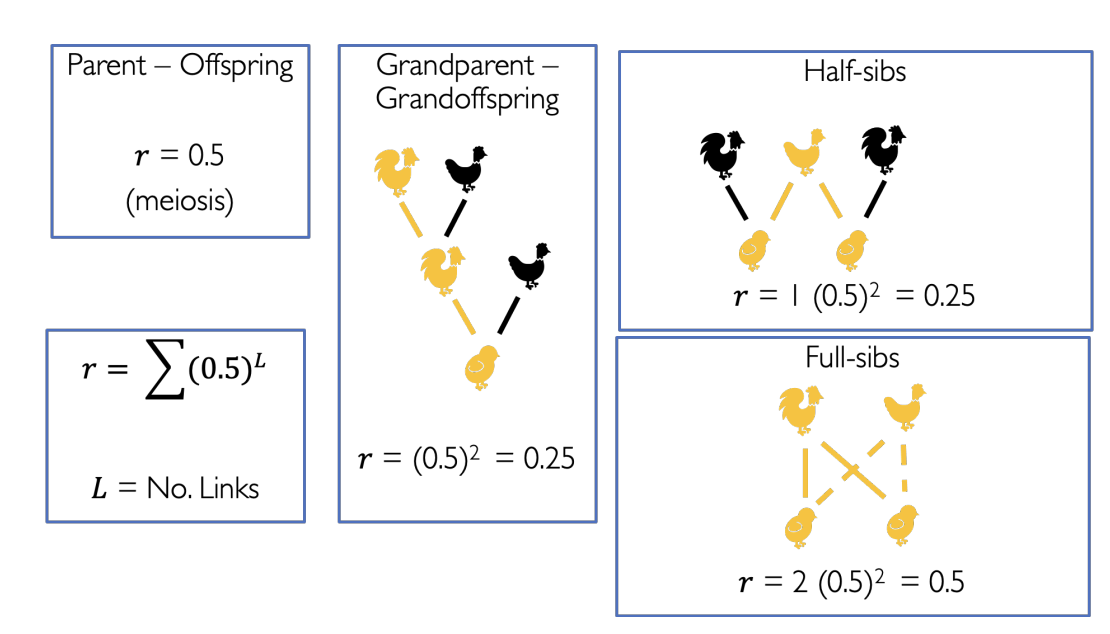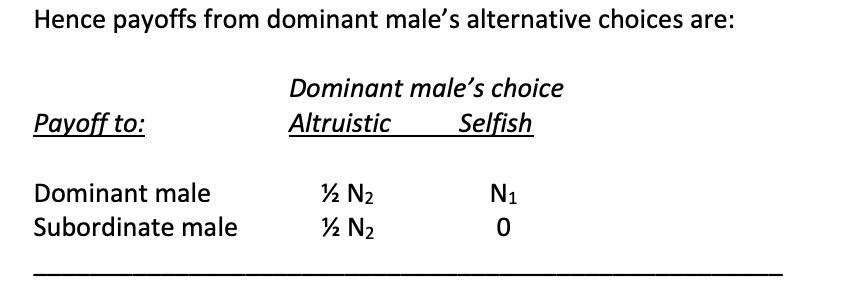Kin selection nad helpers at the nest
1/30
Earn XP
Description and Tags
Lecture 2
Name | Mastery | Learn | Test | Matching | Spaced |
|---|
No study sessions yet.
31 Terms
Way to pass down copies of your genes
Direct fitness
own offspring
Indirect fitness
helping relatives with their offsrping
Most obvious examples of indirect fitness
Sterile worker castes i social insects
spend entire lives helping queen reproduce
Birds and mammals
‘helpers in the nest’
Florida Scrub Jays
Stay with parents and help them raise their broods
2 effects:
increase success of current brood
reduce breeders’ effort = increase future success for breeder
When to help and when to not?
Often part of life history
Help before they find their own territory
But
Some are helpers their whole life
Cooperative breeding in birds
Described in 10% of all bird species
Cooperative breeding in mammals
in taxa where a monogamous pair monopolise the reproduction
produce large litters
so lots of close relative in the group
who can raise the kin
e.g meerkats?
Altruism
helping other to raise offsrping at a cost to one’s own personal reproductive success
How can altruism evolve? Hypotheses…
Delayed direct fitness benefits
Indirect fitness benefits- Kin selection
Hypothesis 1- Direct fitness
Maintain the group or territory
because the helper needs to breed there in the future
Show Parental quality
Better changes of getting a future mate
e.g Pied Kingfisher
Payment to breeders to stay in territory
e.g superb fairy wren: get punished if they don’t help
Hypothesis 2- Indirect fitness
Can pass copies of genes indirectly by helping siblings
Direct= descendent kin
Indirect = non-descendent kin
Hamilton’s rule
Hamilton’s Rule: rAB
Probability individual B has a copy of a gene in individual A by direct descent
prob they share copies of genes above the background level
background level: because they are the same species
Calculating r from pedigree
r= 0 between random individuals
r=1 between clones
each line = meiosis
so x 0.5
0.5 to the power of how many links there are in a path from one thing to the other
Sum of all the paths

Matching r of descendant to non-descendent
Can get just as much genetic benefit from helping full siblings to having your own kids

Combining both direct and indirect fitness
= Inclusive fitness
Hamilton’s rule
If a Donor sacrifices C offspring
Recipient gains an additional B offspring
altruism is favoured when
rB - C> 0
the indirect benefits to the donor (rB) is greater than the costs to the donor
Testing the theory: Mate sharing by Males example 1
Tasmanian native hens
breed as pairs or two male trios (With brothers)
one of the brothers in dominant
But: allows the his brother to copulate
In a trio: there are overall more offspring

Is this an example of kin selected altruism?
The payoffs from dominant male’s alternative choices
Assuming equal share of matings
If dominant male is altruistic:
Benefit to subordinate male= 1/2N2 -0
cost to dominant male = N1 -1/2N2
Apply rB-C>0
If r=0, altruistic is ½ N2 > N1
(4.8<6.6 → NOT altruistic payoff)
if r=1.2 altruistic if 3/4N2 >N1)
7.2>6.6 so dominant male gains a larger genetic profti from altruism

Testing the theory: Mate sharing by Males example 2
Human fraternal polyandry in Tibet
Wife with several brothers fro husbands
Under harsh conditions
may pay for dominant male to cooperate with younger brothers
increases productivity
increases no. offspring

Is this altruism?
Same equations as with hens:
¾ N2>N1
Altruism (just)
Limitations with these studies
Details paternity sharing are not yet known
Dominant males may not be making the decisions
e.g females benefit from increased male help
Human societies: culture has an influence
Testing the theory: Seychelles Warblers
Young stay at home to help their parents to raise further broods
Why?
habitat saturation
not enough free territory for offspring to leave so stay at home and claim indirect benefits

Initially assumed that breeders had full paternity
So the genetic benefit for helping siblings is 0.2 but breding is 0.4
Then why do they help???

Why do they help if it is less fitness? Hypothesis 1
Ecological constraint
full haitat with no opportunity to breed
Test:
new islands= no helping at first
until fully saturated
BUT: other issues found with DNA profiles
high levels of extra group paternity in Seychelles
Female helpers often lay eggs in nest
so direct is MORE important than indirect for female helpers especially

So, new views on why helping happens
A decision favoured by kin selection
By-product of a provisioning rule
selected in the context of parental care
View 1: Helping is a decision
Helpers do not always help
vary help depending on chances of relatedness to nestlings
Evidence favours this one more
When are you more likely to help
If the primary female is still present
85% chance young in nest is from primary female
You have 85% shes your mum
so, her next offspring are 85% hers
Probability helper is related to offspring 0.85 ×0.85= 0.72
Less reliable cue
Continued presence of primary male
Only 60% of chicks are the father’s
Prob hes your dad 0.6
prob hell father the young 0.6
Prob they are your sibs: 0.6×0.6= 0.36
So when do helpers actually help more?
Need a reliable cue that they actually are related to the siblings
best cue is if primary mother still present
Other cues used to ensure relatedness
E.g Long-tailed tits
cross-fostering experiments
showed they learn signature calls from provisioning adults
target these individuals when they go to help them
View 2: provisioning by-product
When a habitat is full and offspring stay at home
they will naturally help feed due to begging chicks
Beneficial
But also do this for cuckoo care
costly
Therefore not really selected for: just a by-product